CUC100: Food Production, Sustainability, and Environmental Concerns
VerifiedAdded on 2022/11/27
|9
|2513
|156
Essay
AI Summary
This essay examines the multifaceted aspects of food production, emphasizing its critical role in sustaining human life and the environment. It focuses on the context of India, particularly Punjab, and delves into key sustainability concerns from environmental, economic, and social perspectives. The essay highlights the challenges of balancing food production with the demands of a growing population, the impacts of agricultural practices on soil quality and biodiversity, and the need for sustainable development. It explores the concept of a sustainable food system, the environmental impacts of food production, and the economic and social implications. The essay discusses the importance of farmer engagement, technological innovation, and community participation in addressing the issues of global hunger, environmental degradation, and poverty. It underscores the need for a balanced approach that considers environmental, social, and economic factors to improve the quality of life and ensure a sustainable future for food production.
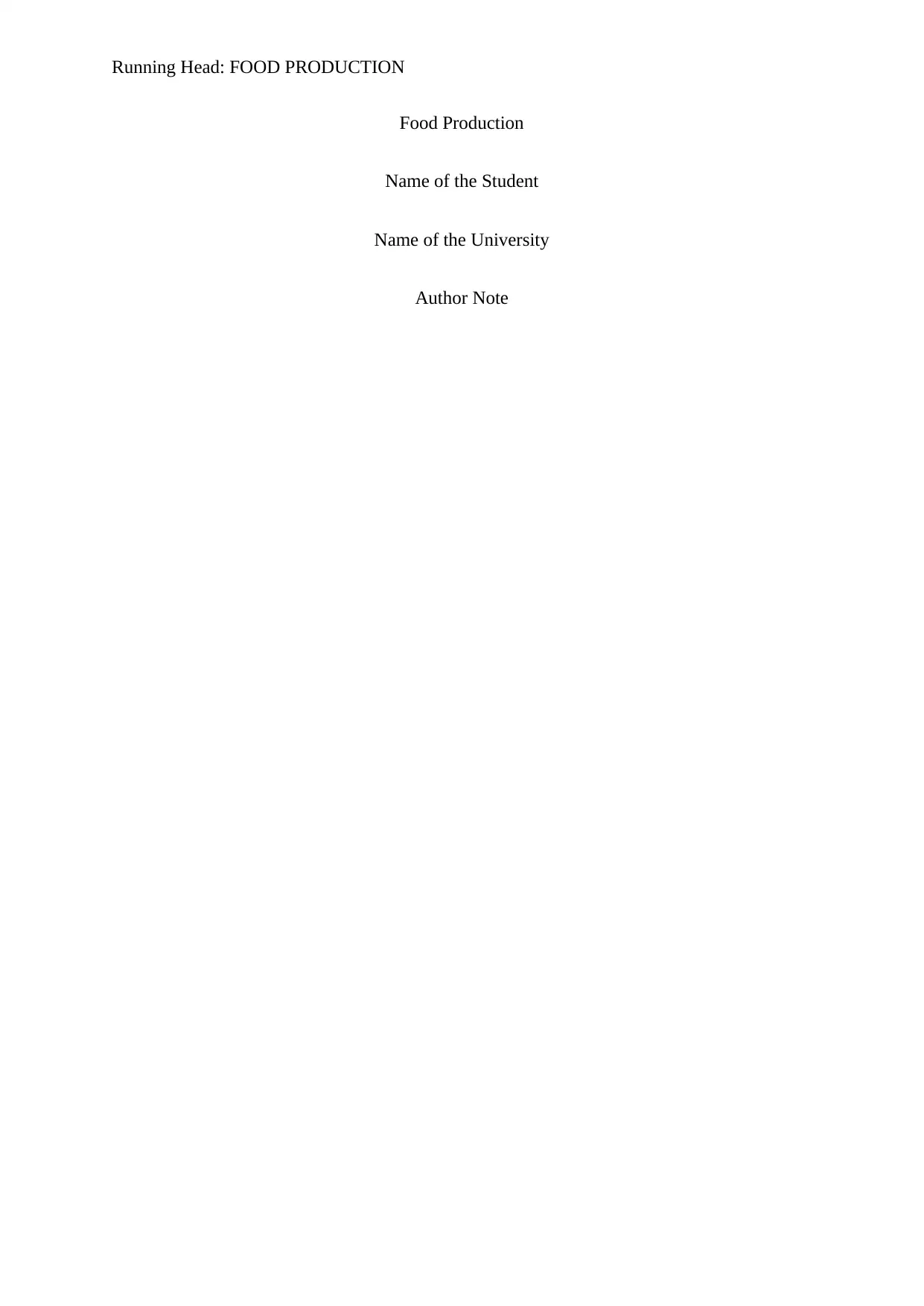
Running Head: FOOD PRODUCTION
Food Production
Name of the Student
Name of the University
Author Note
Food Production
Name of the Student
Name of the University
Author Note
Paraphrase This Document
Need a fresh take? Get an instant paraphrase of this document with our AI Paraphraser
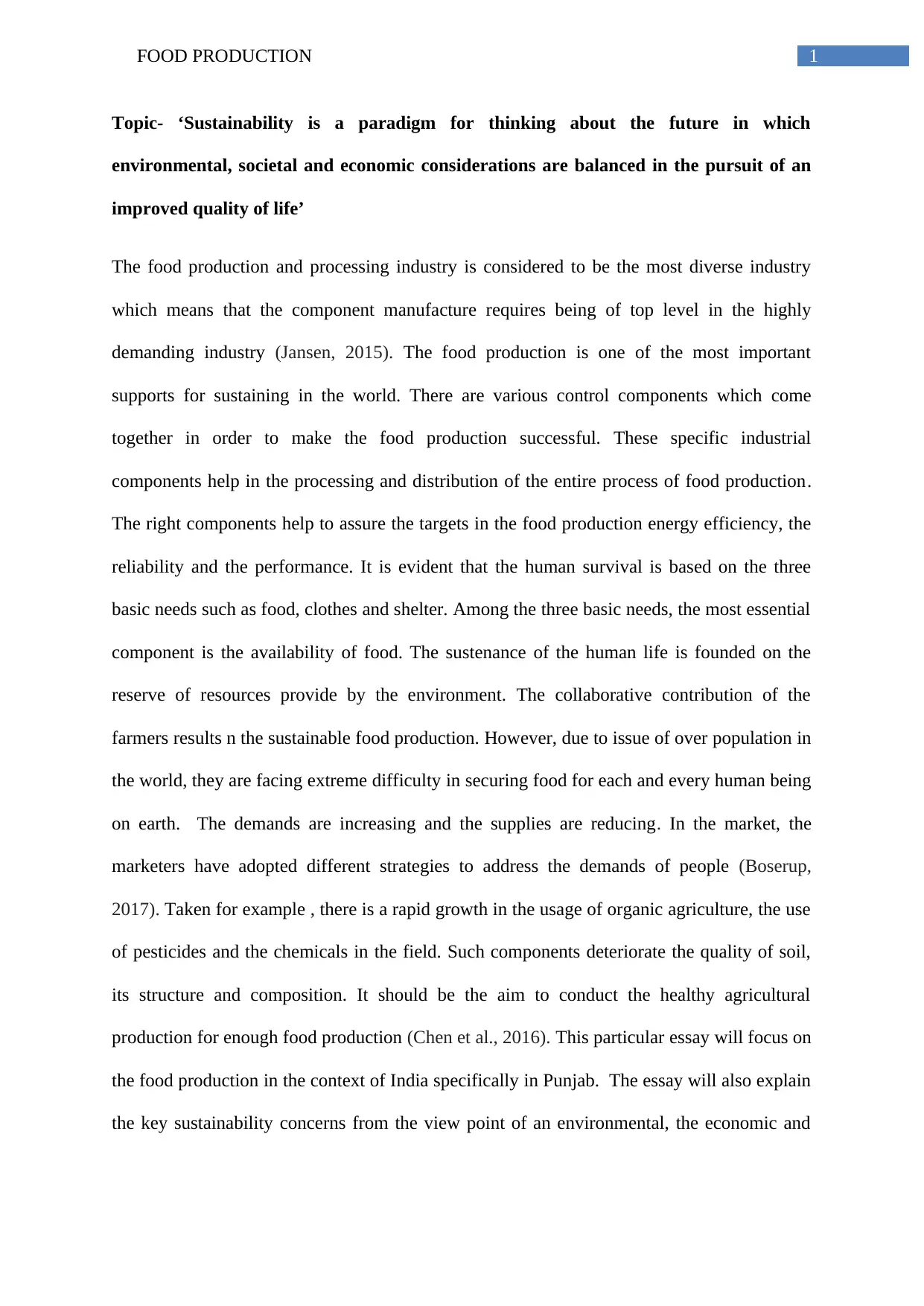
1FOOD PRODUCTION
Topic- ‘Sustainability is a paradigm for thinking about the future in which
environmental, societal and economic considerations are balanced in the pursuit of an
improved quality of life’
The food production and processing industry is considered to be the most diverse industry
which means that the component manufacture requires being of top level in the highly
demanding industry (Jansen, 2015). The food production is one of the most important
supports for sustaining in the world. There are various control components which come
together in order to make the food production successful. These specific industrial
components help in the processing and distribution of the entire process of food production.
The right components help to assure the targets in the food production energy efficiency, the
reliability and the performance. It is evident that the human survival is based on the three
basic needs such as food, clothes and shelter. Among the three basic needs, the most essential
component is the availability of food. The sustenance of the human life is founded on the
reserve of resources provide by the environment. The collaborative contribution of the
farmers results n the sustainable food production. However, due to issue of over population in
the world, they are facing extreme difficulty in securing food for each and every human being
on earth. The demands are increasing and the supplies are reducing. In the market, the
marketers have adopted different strategies to address the demands of people (Boserup,
2017). Taken for example , there is a rapid growth in the usage of organic agriculture, the use
of pesticides and the chemicals in the field. Such components deteriorate the quality of soil,
its structure and composition. It should be the aim to conduct the healthy agricultural
production for enough food production (Chen et al., 2016). This particular essay will focus on
the food production in the context of India specifically in Punjab. The essay will also explain
the key sustainability concerns from the view point of an environmental, the economic and
Topic- ‘Sustainability is a paradigm for thinking about the future in which
environmental, societal and economic considerations are balanced in the pursuit of an
improved quality of life’
The food production and processing industry is considered to be the most diverse industry
which means that the component manufacture requires being of top level in the highly
demanding industry (Jansen, 2015). The food production is one of the most important
supports for sustaining in the world. There are various control components which come
together in order to make the food production successful. These specific industrial
components help in the processing and distribution of the entire process of food production.
The right components help to assure the targets in the food production energy efficiency, the
reliability and the performance. It is evident that the human survival is based on the three
basic needs such as food, clothes and shelter. Among the three basic needs, the most essential
component is the availability of food. The sustenance of the human life is founded on the
reserve of resources provide by the environment. The collaborative contribution of the
farmers results n the sustainable food production. However, due to issue of over population in
the world, they are facing extreme difficulty in securing food for each and every human being
on earth. The demands are increasing and the supplies are reducing. In the market, the
marketers have adopted different strategies to address the demands of people (Boserup,
2017). Taken for example , there is a rapid growth in the usage of organic agriculture, the use
of pesticides and the chemicals in the field. Such components deteriorate the quality of soil,
its structure and composition. It should be the aim to conduct the healthy agricultural
production for enough food production (Chen et al., 2016). This particular essay will focus on
the food production in the context of India specifically in Punjab. The essay will also explain
the key sustainability concerns from the view point of an environmental, the economic and
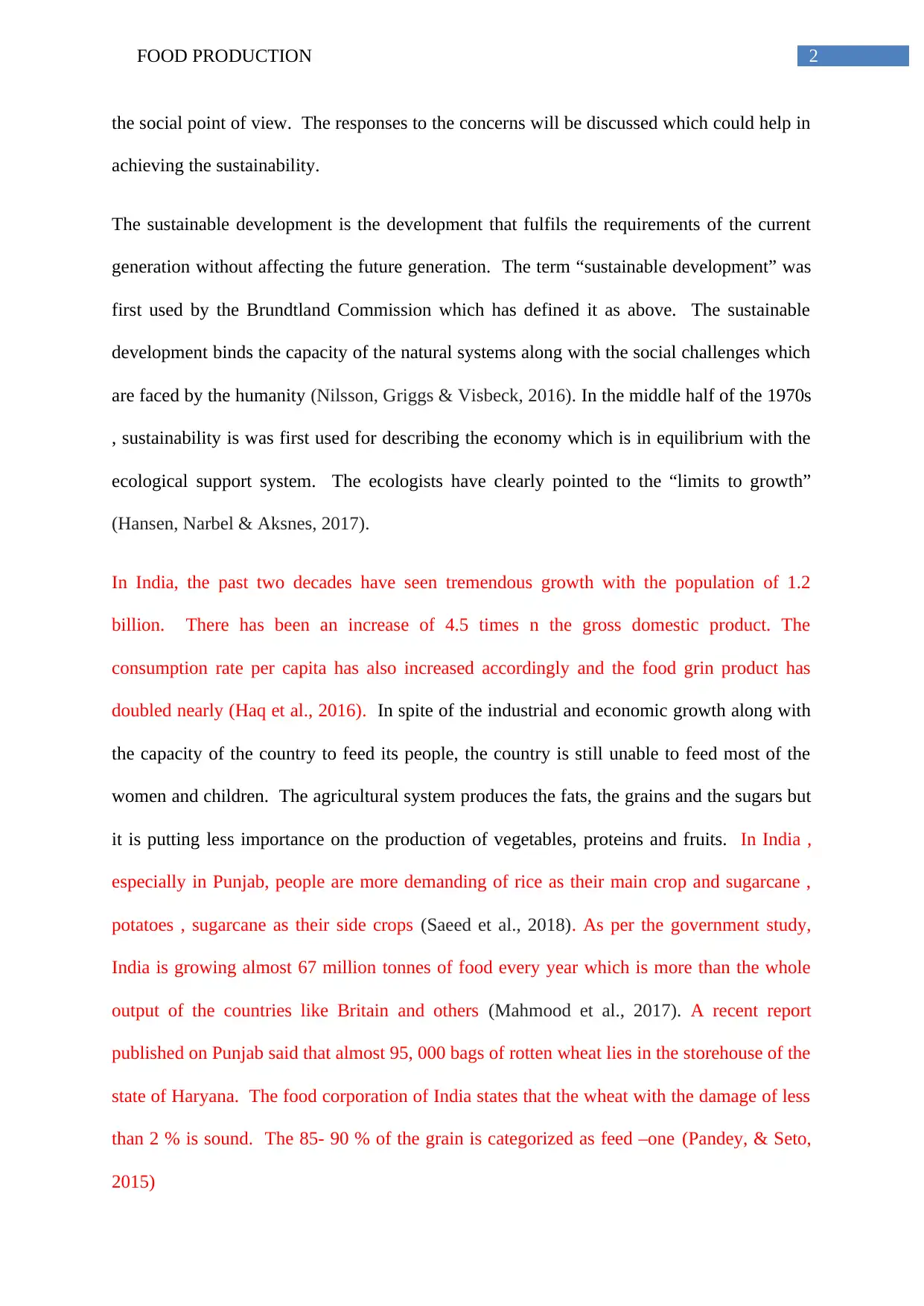
2FOOD PRODUCTION
the social point of view. The responses to the concerns will be discussed which could help in
achieving the sustainability.
The sustainable development is the development that fulfils the requirements of the current
generation without affecting the future generation. The term “sustainable development” was
first used by the Brundtland Commission which has defined it as above. The sustainable
development binds the capacity of the natural systems along with the social challenges which
are faced by the humanity (Nilsson, Griggs & Visbeck, 2016). In the middle half of the 1970s
, sustainability is was first used for describing the economy which is in equilibrium with the
ecological support system. The ecologists have clearly pointed to the “limits to growth”
(Hansen, Narbel & Aksnes, 2017).
In India, the past two decades have seen tremendous growth with the population of 1.2
billion. There has been an increase of 4.5 times n the gross domestic product. The
consumption rate per capita has also increased accordingly and the food grin product has
doubled nearly (Haq et al., 2016). In spite of the industrial and economic growth along with
the capacity of the country to feed its people, the country is still unable to feed most of the
women and children. The agricultural system produces the fats, the grains and the sugars but
it is putting less importance on the production of vegetables, proteins and fruits. In India ,
especially in Punjab, people are more demanding of rice as their main crop and sugarcane ,
potatoes , sugarcane as their side crops (Saeed et al., 2018). As per the government study,
India is growing almost 67 million tonnes of food every year which is more than the whole
output of the countries like Britain and others (Mahmood et al., 2017). A recent report
published on Punjab said that almost 95, 000 bags of rotten wheat lies in the storehouse of the
state of Haryana. The food corporation of India states that the wheat with the damage of less
than 2 % is sound. The 85- 90 % of the grain is categorized as feed –one (Pandey, & Seto,
2015)
the social point of view. The responses to the concerns will be discussed which could help in
achieving the sustainability.
The sustainable development is the development that fulfils the requirements of the current
generation without affecting the future generation. The term “sustainable development” was
first used by the Brundtland Commission which has defined it as above. The sustainable
development binds the capacity of the natural systems along with the social challenges which
are faced by the humanity (Nilsson, Griggs & Visbeck, 2016). In the middle half of the 1970s
, sustainability is was first used for describing the economy which is in equilibrium with the
ecological support system. The ecologists have clearly pointed to the “limits to growth”
(Hansen, Narbel & Aksnes, 2017).
In India, the past two decades have seen tremendous growth with the population of 1.2
billion. There has been an increase of 4.5 times n the gross domestic product. The
consumption rate per capita has also increased accordingly and the food grin product has
doubled nearly (Haq et al., 2016). In spite of the industrial and economic growth along with
the capacity of the country to feed its people, the country is still unable to feed most of the
women and children. The agricultural system produces the fats, the grains and the sugars but
it is putting less importance on the production of vegetables, proteins and fruits. In India ,
especially in Punjab, people are more demanding of rice as their main crop and sugarcane ,
potatoes , sugarcane as their side crops (Saeed et al., 2018). As per the government study,
India is growing almost 67 million tonnes of food every year which is more than the whole
output of the countries like Britain and others (Mahmood et al., 2017). A recent report
published on Punjab said that almost 95, 000 bags of rotten wheat lies in the storehouse of the
state of Haryana. The food corporation of India states that the wheat with the damage of less
than 2 % is sound. The 85- 90 % of the grain is categorized as feed –one (Pandey, & Seto,
2015)
⊘ This is a preview!⊘
Do you want full access?
Subscribe today to unlock all pages.

Trusted by 1+ million students worldwide
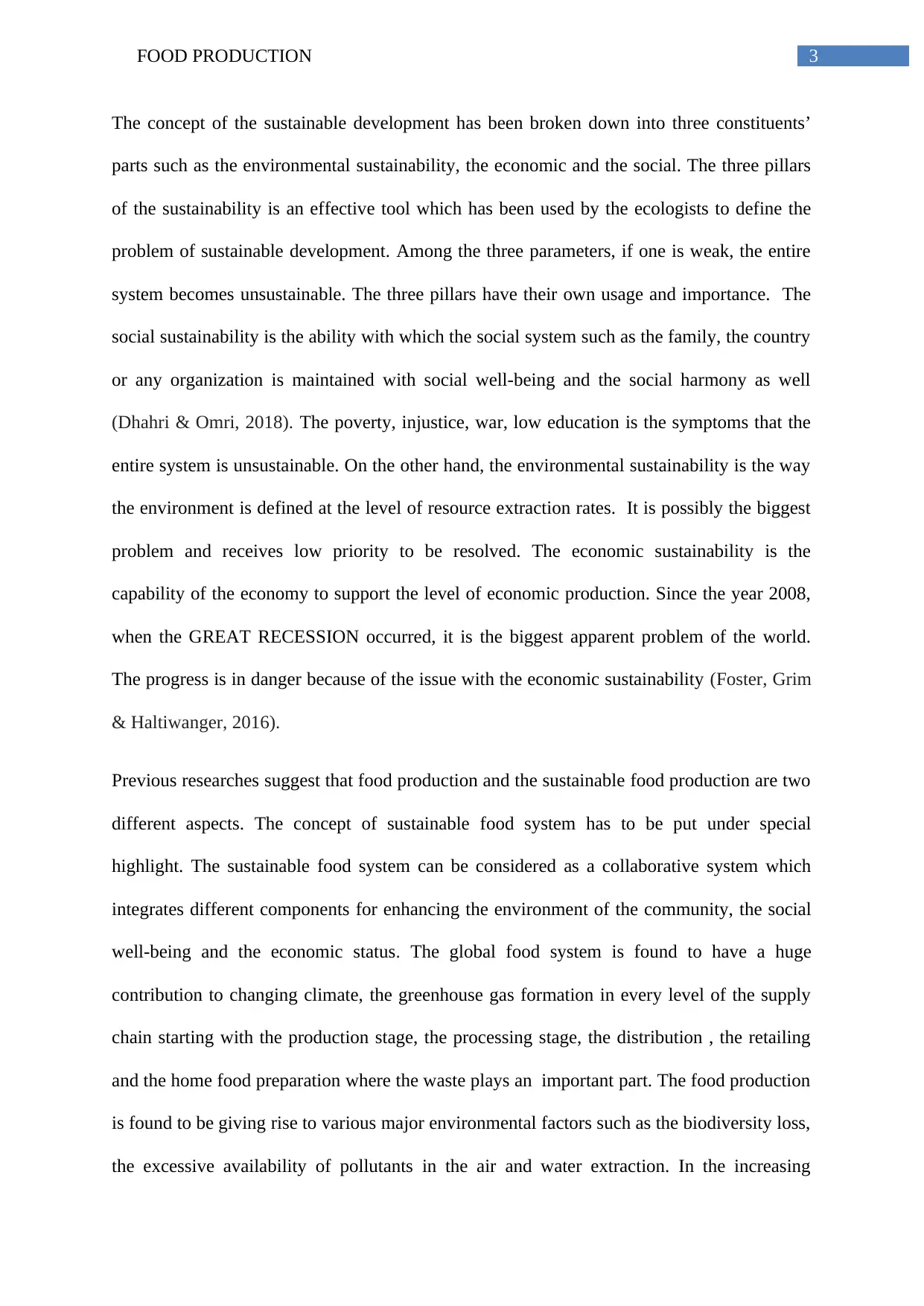
3FOOD PRODUCTION
The concept of the sustainable development has been broken down into three constituents’
parts such as the environmental sustainability, the economic and the social. The three pillars
of the sustainability is an effective tool which has been used by the ecologists to define the
problem of sustainable development. Among the three parameters, if one is weak, the entire
system becomes unsustainable. The three pillars have their own usage and importance. The
social sustainability is the ability with which the social system such as the family, the country
or any organization is maintained with social well-being and the social harmony as well
(Dhahri & Omri, 2018). The poverty, injustice, war, low education is the symptoms that the
entire system is unsustainable. On the other hand, the environmental sustainability is the way
the environment is defined at the level of resource extraction rates. It is possibly the biggest
problem and receives low priority to be resolved. The economic sustainability is the
capability of the economy to support the level of economic production. Since the year 2008,
when the GREAT RECESSION occurred, it is the biggest apparent problem of the world.
The progress is in danger because of the issue with the economic sustainability (Foster, Grim
& Haltiwanger, 2016).
Previous researches suggest that food production and the sustainable food production are two
different aspects. The concept of sustainable food system has to be put under special
highlight. The sustainable food system can be considered as a collaborative system which
integrates different components for enhancing the environment of the community, the social
well-being and the economic status. The global food system is found to have a huge
contribution to changing climate, the greenhouse gas formation in every level of the supply
chain starting with the production stage, the processing stage, the distribution , the retailing
and the home food preparation where the waste plays an important part. The food production
is found to be giving rise to various major environmental factors such as the biodiversity loss,
the excessive availability of pollutants in the air and water extraction. In the increasing
The concept of the sustainable development has been broken down into three constituents’
parts such as the environmental sustainability, the economic and the social. The three pillars
of the sustainability is an effective tool which has been used by the ecologists to define the
problem of sustainable development. Among the three parameters, if one is weak, the entire
system becomes unsustainable. The three pillars have their own usage and importance. The
social sustainability is the ability with which the social system such as the family, the country
or any organization is maintained with social well-being and the social harmony as well
(Dhahri & Omri, 2018). The poverty, injustice, war, low education is the symptoms that the
entire system is unsustainable. On the other hand, the environmental sustainability is the way
the environment is defined at the level of resource extraction rates. It is possibly the biggest
problem and receives low priority to be resolved. The economic sustainability is the
capability of the economy to support the level of economic production. Since the year 2008,
when the GREAT RECESSION occurred, it is the biggest apparent problem of the world.
The progress is in danger because of the issue with the economic sustainability (Foster, Grim
& Haltiwanger, 2016).
Previous researches suggest that food production and the sustainable food production are two
different aspects. The concept of sustainable food system has to be put under special
highlight. The sustainable food system can be considered as a collaborative system which
integrates different components for enhancing the environment of the community, the social
well-being and the economic status. The global food system is found to have a huge
contribution to changing climate, the greenhouse gas formation in every level of the supply
chain starting with the production stage, the processing stage, the distribution , the retailing
and the home food preparation where the waste plays an important part. The food production
is found to be giving rise to various major environmental factors such as the biodiversity loss,
the excessive availability of pollutants in the air and water extraction. In the increasing
Paraphrase This Document
Need a fresh take? Get an instant paraphrase of this document with our AI Paraphraser
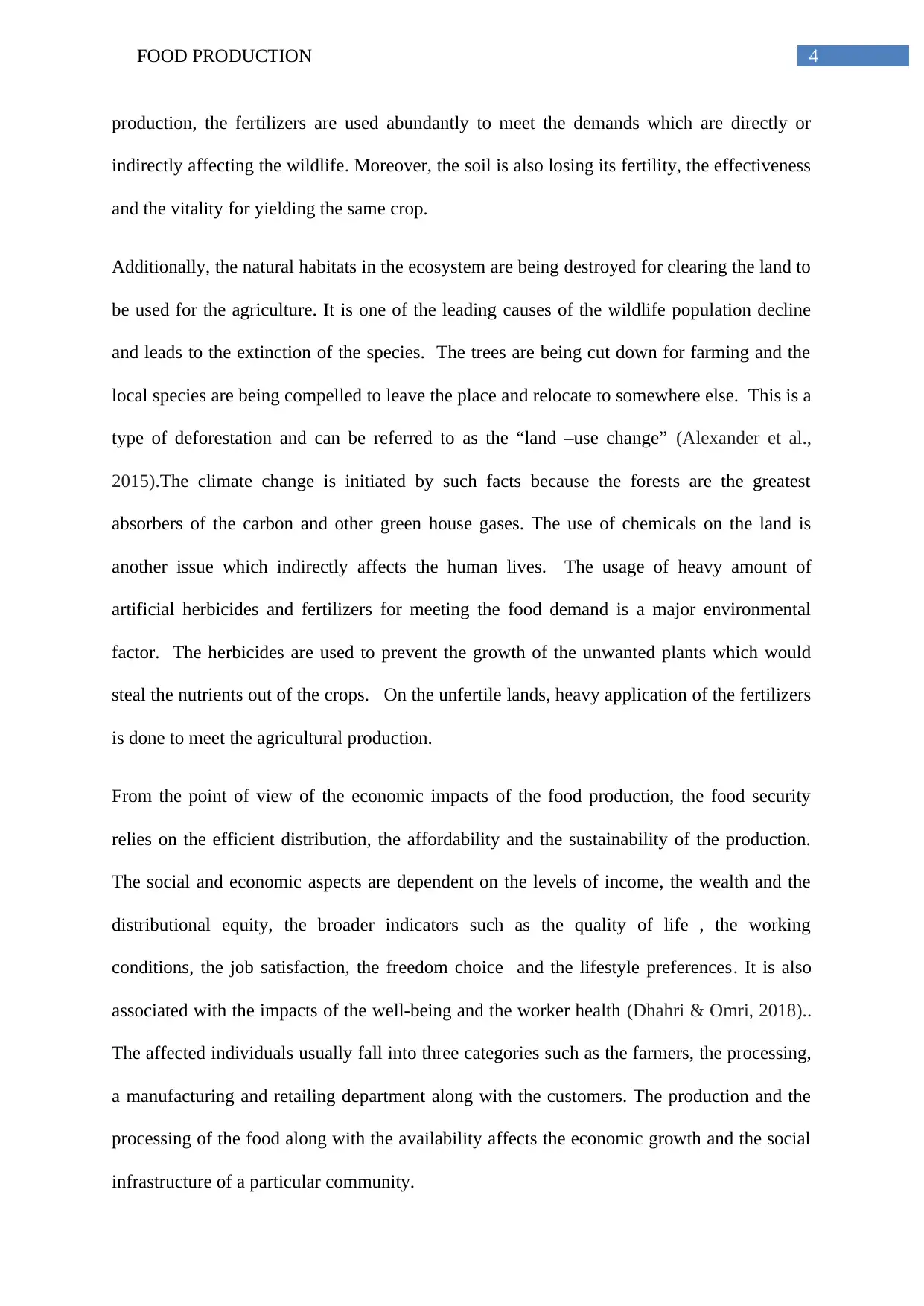
4FOOD PRODUCTION
production, the fertilizers are used abundantly to meet the demands which are directly or
indirectly affecting the wildlife. Moreover, the soil is also losing its fertility, the effectiveness
and the vitality for yielding the same crop.
Additionally, the natural habitats in the ecosystem are being destroyed for clearing the land to
be used for the agriculture. It is one of the leading causes of the wildlife population decline
and leads to the extinction of the species. The trees are being cut down for farming and the
local species are being compelled to leave the place and relocate to somewhere else. This is a
type of deforestation and can be referred to as the “land –use change” (Alexander et al.,
2015).The climate change is initiated by such facts because the forests are the greatest
absorbers of the carbon and other green house gases. The use of chemicals on the land is
another issue which indirectly affects the human lives. The usage of heavy amount of
artificial herbicides and fertilizers for meeting the food demand is a major environmental
factor. The herbicides are used to prevent the growth of the unwanted plants which would
steal the nutrients out of the crops. On the unfertile lands, heavy application of the fertilizers
is done to meet the agricultural production.
From the point of view of the economic impacts of the food production, the food security
relies on the efficient distribution, the affordability and the sustainability of the production.
The social and economic aspects are dependent on the levels of income, the wealth and the
distributional equity, the broader indicators such as the quality of life , the working
conditions, the job satisfaction, the freedom choice and the lifestyle preferences. It is also
associated with the impacts of the well-being and the worker health (Dhahri & Omri, 2018)..
The affected individuals usually fall into three categories such as the farmers, the processing,
a manufacturing and retailing department along with the customers. The production and the
processing of the food along with the availability affects the economic growth and the social
infrastructure of a particular community.
production, the fertilizers are used abundantly to meet the demands which are directly or
indirectly affecting the wildlife. Moreover, the soil is also losing its fertility, the effectiveness
and the vitality for yielding the same crop.
Additionally, the natural habitats in the ecosystem are being destroyed for clearing the land to
be used for the agriculture. It is one of the leading causes of the wildlife population decline
and leads to the extinction of the species. The trees are being cut down for farming and the
local species are being compelled to leave the place and relocate to somewhere else. This is a
type of deforestation and can be referred to as the “land –use change” (Alexander et al.,
2015).The climate change is initiated by such facts because the forests are the greatest
absorbers of the carbon and other green house gases. The use of chemicals on the land is
another issue which indirectly affects the human lives. The usage of heavy amount of
artificial herbicides and fertilizers for meeting the food demand is a major environmental
factor. The herbicides are used to prevent the growth of the unwanted plants which would
steal the nutrients out of the crops. On the unfertile lands, heavy application of the fertilizers
is done to meet the agricultural production.
From the point of view of the economic impacts of the food production, the food security
relies on the efficient distribution, the affordability and the sustainability of the production.
The social and economic aspects are dependent on the levels of income, the wealth and the
distributional equity, the broader indicators such as the quality of life , the working
conditions, the job satisfaction, the freedom choice and the lifestyle preferences. It is also
associated with the impacts of the well-being and the worker health (Dhahri & Omri, 2018)..
The affected individuals usually fall into three categories such as the farmers, the processing,
a manufacturing and retailing department along with the customers. The production and the
processing of the food along with the availability affects the economic growth and the social
infrastructure of a particular community.
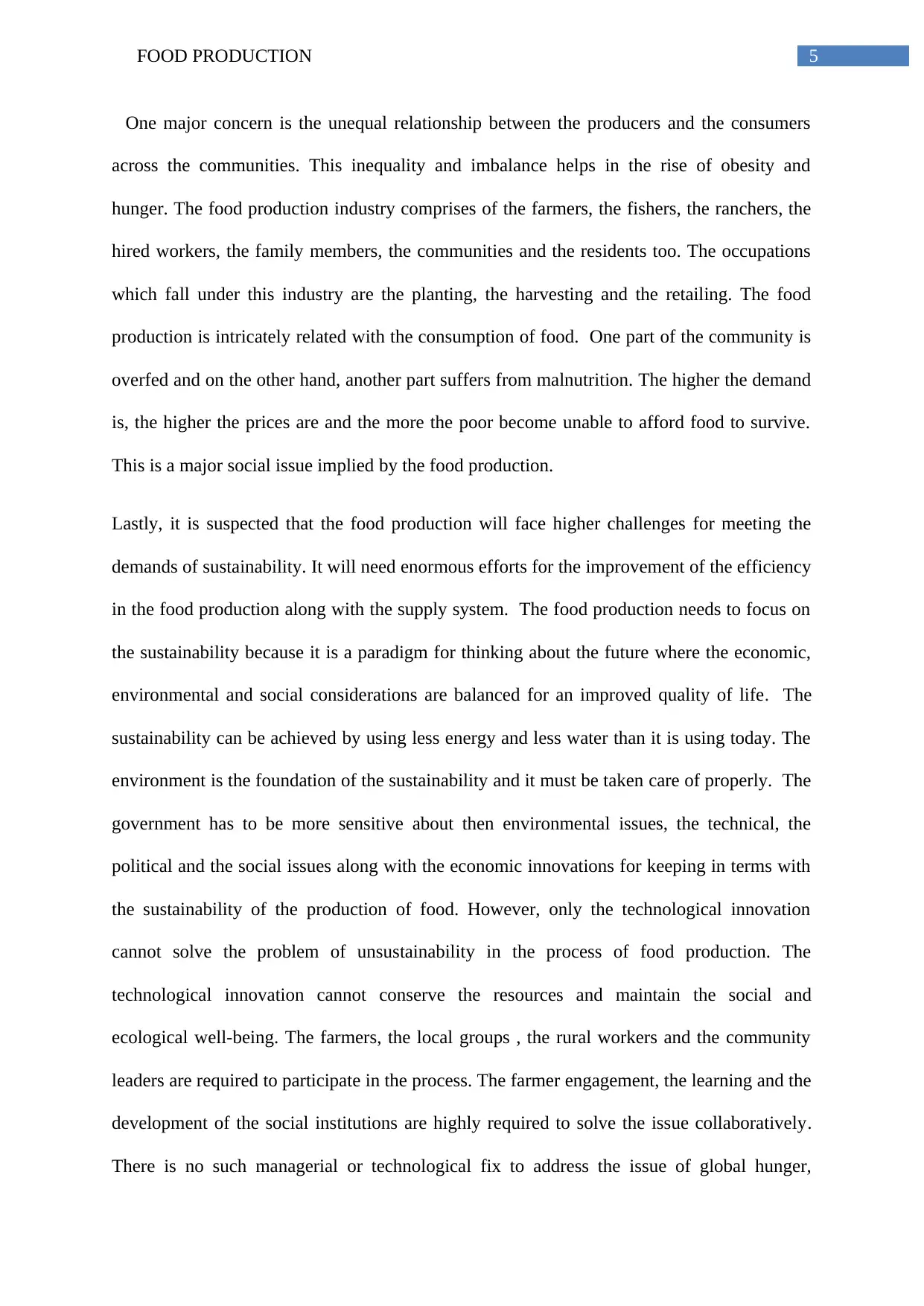
5FOOD PRODUCTION
One major concern is the unequal relationship between the producers and the consumers
across the communities. This inequality and imbalance helps in the rise of obesity and
hunger. The food production industry comprises of the farmers, the fishers, the ranchers, the
hired workers, the family members, the communities and the residents too. The occupations
which fall under this industry are the planting, the harvesting and the retailing. The food
production is intricately related with the consumption of food. One part of the community is
overfed and on the other hand, another part suffers from malnutrition. The higher the demand
is, the higher the prices are and the more the poor become unable to afford food to survive.
This is a major social issue implied by the food production.
Lastly, it is suspected that the food production will face higher challenges for meeting the
demands of sustainability. It will need enormous efforts for the improvement of the efficiency
in the food production along with the supply system. The food production needs to focus on
the sustainability because it is a paradigm for thinking about the future where the economic,
environmental and social considerations are balanced for an improved quality of life. The
sustainability can be achieved by using less energy and less water than it is using today. The
environment is the foundation of the sustainability and it must be taken care of properly. The
government has to be more sensitive about then environmental issues, the technical, the
political and the social issues along with the economic innovations for keeping in terms with
the sustainability of the production of food. However, only the technological innovation
cannot solve the problem of unsustainability in the process of food production. The
technological innovation cannot conserve the resources and maintain the social and
ecological well-being. The farmers, the local groups , the rural workers and the community
leaders are required to participate in the process. The farmer engagement, the learning and the
development of the social institutions are highly required to solve the issue collaboratively.
There is no such managerial or technological fix to address the issue of global hunger,
One major concern is the unequal relationship between the producers and the consumers
across the communities. This inequality and imbalance helps in the rise of obesity and
hunger. The food production industry comprises of the farmers, the fishers, the ranchers, the
hired workers, the family members, the communities and the residents too. The occupations
which fall under this industry are the planting, the harvesting and the retailing. The food
production is intricately related with the consumption of food. One part of the community is
overfed and on the other hand, another part suffers from malnutrition. The higher the demand
is, the higher the prices are and the more the poor become unable to afford food to survive.
This is a major social issue implied by the food production.
Lastly, it is suspected that the food production will face higher challenges for meeting the
demands of sustainability. It will need enormous efforts for the improvement of the efficiency
in the food production along with the supply system. The food production needs to focus on
the sustainability because it is a paradigm for thinking about the future where the economic,
environmental and social considerations are balanced for an improved quality of life. The
sustainability can be achieved by using less energy and less water than it is using today. The
environment is the foundation of the sustainability and it must be taken care of properly. The
government has to be more sensitive about then environmental issues, the technical, the
political and the social issues along with the economic innovations for keeping in terms with
the sustainability of the production of food. However, only the technological innovation
cannot solve the problem of unsustainability in the process of food production. The
technological innovation cannot conserve the resources and maintain the social and
ecological well-being. The farmers, the local groups , the rural workers and the community
leaders are required to participate in the process. The farmer engagement, the learning and the
development of the social institutions are highly required to solve the issue collaboratively.
There is no such managerial or technological fix to address the issue of global hunger,
⊘ This is a preview!⊘
Do you want full access?
Subscribe today to unlock all pages.

Trusted by 1+ million students worldwide
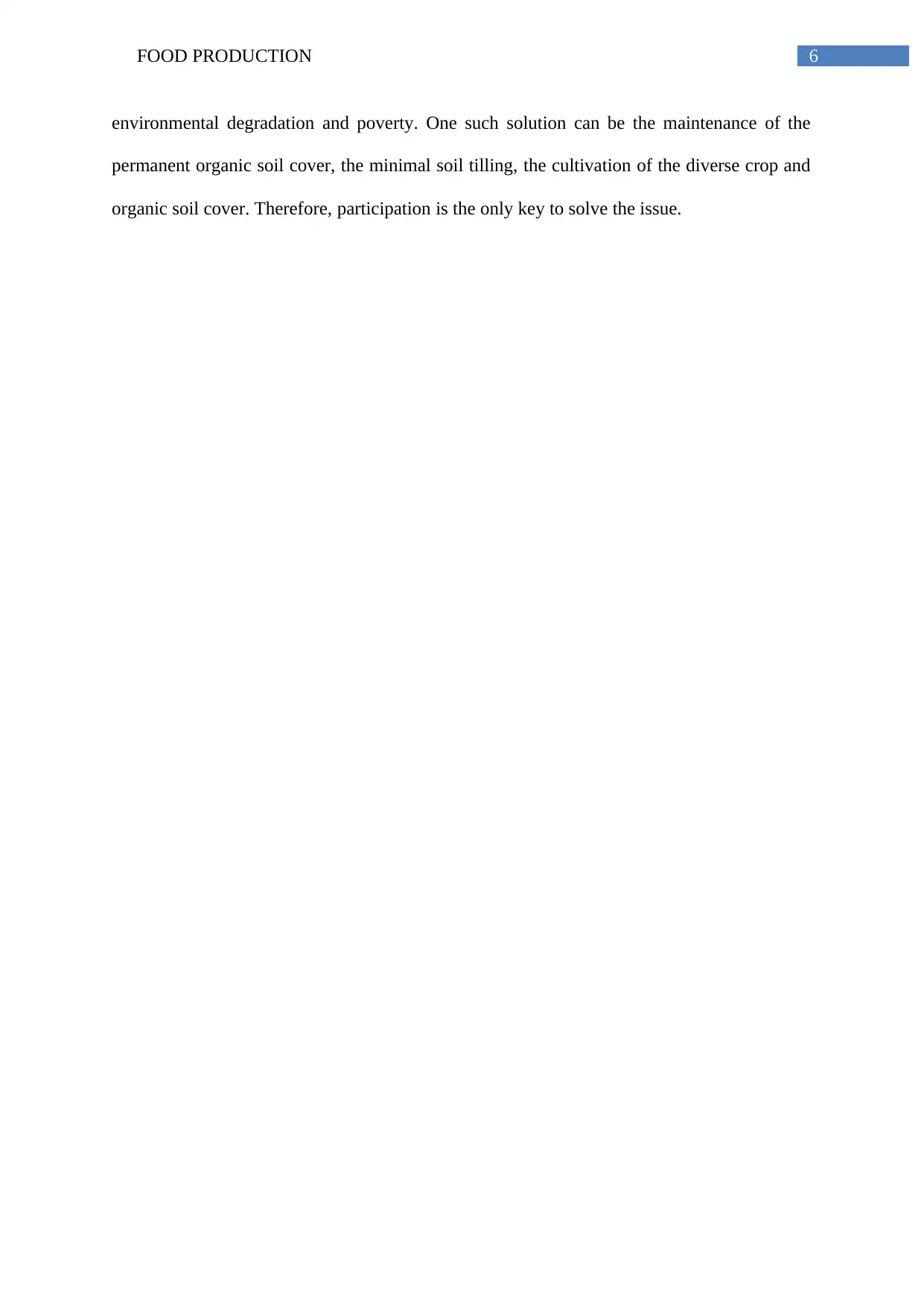
6FOOD PRODUCTION
environmental degradation and poverty. One such solution can be the maintenance of the
permanent organic soil cover, the minimal soil tilling, the cultivation of the diverse crop and
organic soil cover. Therefore, participation is the only key to solve the issue.
environmental degradation and poverty. One such solution can be the maintenance of the
permanent organic soil cover, the minimal soil tilling, the cultivation of the diverse crop and
organic soil cover. Therefore, participation is the only key to solve the issue.
Paraphrase This Document
Need a fresh take? Get an instant paraphrase of this document with our AI Paraphraser
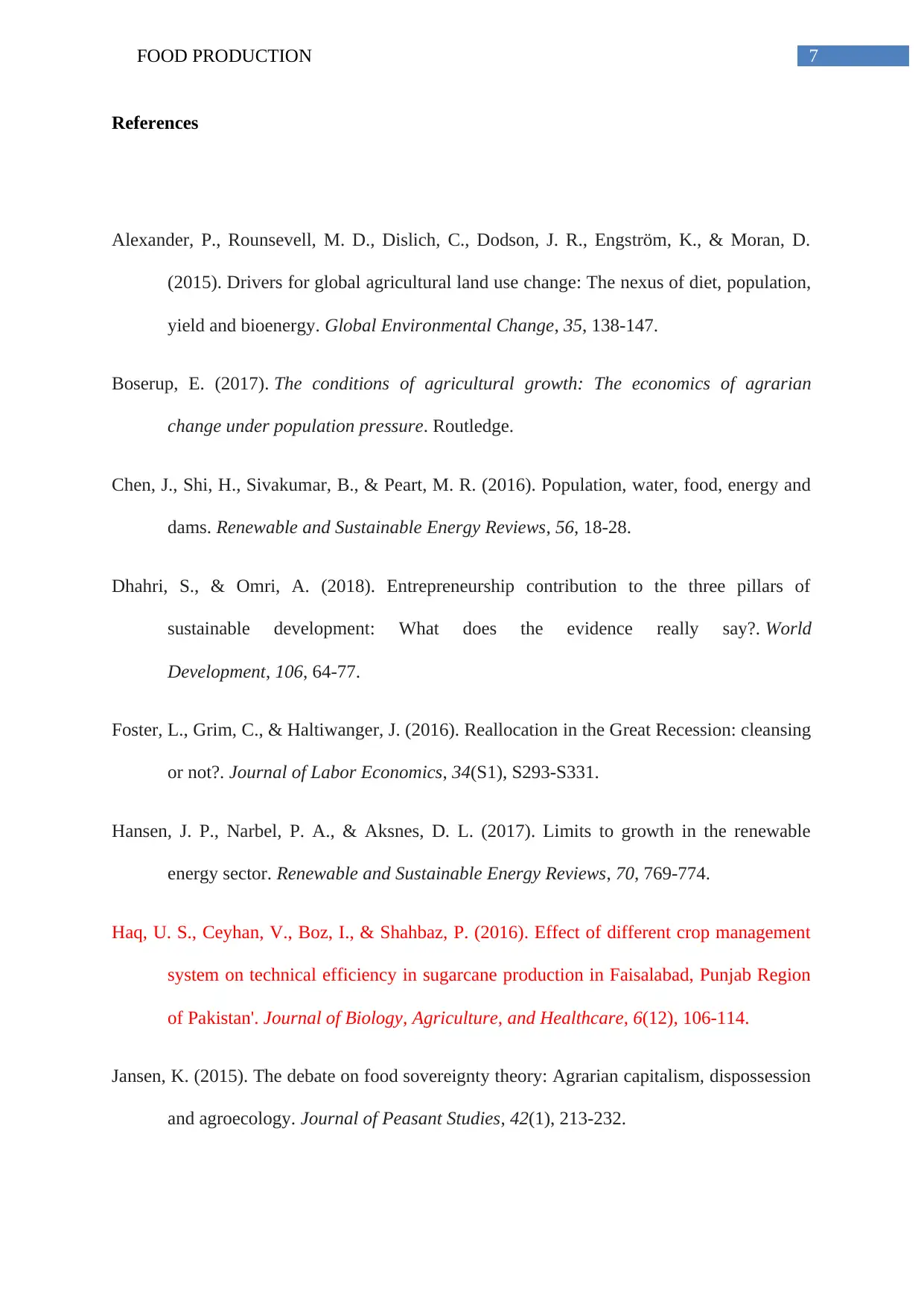
7FOOD PRODUCTION
References
Alexander, P., Rounsevell, M. D., Dislich, C., Dodson, J. R., Engström, K., & Moran, D.
(2015). Drivers for global agricultural land use change: The nexus of diet, population,
yield and bioenergy. Global Environmental Change, 35, 138-147.
Boserup, E. (2017). The conditions of agricultural growth: The economics of agrarian
change under population pressure. Routledge.
Chen, J., Shi, H., Sivakumar, B., & Peart, M. R. (2016). Population, water, food, energy and
dams. Renewable and Sustainable Energy Reviews, 56, 18-28.
Dhahri, S., & Omri, A. (2018). Entrepreneurship contribution to the three pillars of
sustainable development: What does the evidence really say?. World
Development, 106, 64-77.
Foster, L., Grim, C., & Haltiwanger, J. (2016). Reallocation in the Great Recession: cleansing
or not?. Journal of Labor Economics, 34(S1), S293-S331.
Hansen, J. P., Narbel, P. A., & Aksnes, D. L. (2017). Limits to growth in the renewable
energy sector. Renewable and Sustainable Energy Reviews, 70, 769-774.
Haq, U. S., Ceyhan, V., Boz, I., & Shahbaz, P. (2016). Effect of different crop management
system on technical efficiency in sugarcane production in Faisalabad, Punjab Region
of Pakistan'. Journal of Biology, Agriculture, and Healthcare, 6(12), 106-114.
Jansen, K. (2015). The debate on food sovereignty theory: Agrarian capitalism, dispossession
and agroecology. Journal of Peasant Studies, 42(1), 213-232.
References
Alexander, P., Rounsevell, M. D., Dislich, C., Dodson, J. R., Engström, K., & Moran, D.
(2015). Drivers for global agricultural land use change: The nexus of diet, population,
yield and bioenergy. Global Environmental Change, 35, 138-147.
Boserup, E. (2017). The conditions of agricultural growth: The economics of agrarian
change under population pressure. Routledge.
Chen, J., Shi, H., Sivakumar, B., & Peart, M. R. (2016). Population, water, food, energy and
dams. Renewable and Sustainable Energy Reviews, 56, 18-28.
Dhahri, S., & Omri, A. (2018). Entrepreneurship contribution to the three pillars of
sustainable development: What does the evidence really say?. World
Development, 106, 64-77.
Foster, L., Grim, C., & Haltiwanger, J. (2016). Reallocation in the Great Recession: cleansing
or not?. Journal of Labor Economics, 34(S1), S293-S331.
Hansen, J. P., Narbel, P. A., & Aksnes, D. L. (2017). Limits to growth in the renewable
energy sector. Renewable and Sustainable Energy Reviews, 70, 769-774.
Haq, U. S., Ceyhan, V., Boz, I., & Shahbaz, P. (2016). Effect of different crop management
system on technical efficiency in sugarcane production in Faisalabad, Punjab Region
of Pakistan'. Journal of Biology, Agriculture, and Healthcare, 6(12), 106-114.
Jansen, K. (2015). The debate on food sovereignty theory: Agrarian capitalism, dispossession
and agroecology. Journal of Peasant Studies, 42(1), 213-232.
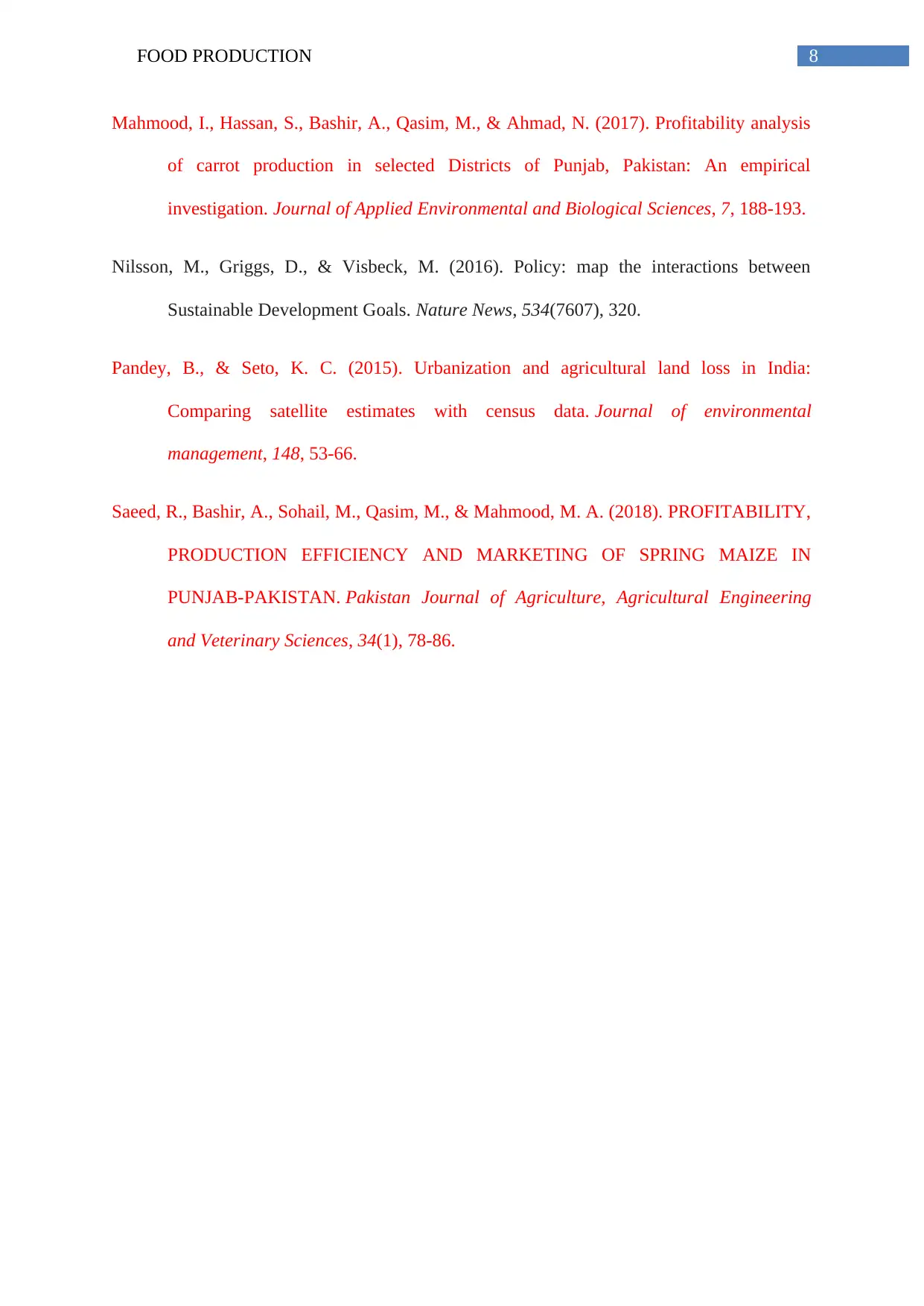
8FOOD PRODUCTION
Mahmood, I., Hassan, S., Bashir, A., Qasim, M., & Ahmad, N. (2017). Profitability analysis
of carrot production in selected Districts of Punjab, Pakistan: An empirical
investigation. Journal of Applied Environmental and Biological Sciences, 7, 188-193.
Nilsson, M., Griggs, D., & Visbeck, M. (2016). Policy: map the interactions between
Sustainable Development Goals. Nature News, 534(7607), 320.
Pandey, B., & Seto, K. C. (2015). Urbanization and agricultural land loss in India:
Comparing satellite estimates with census data. Journal of environmental
management, 148, 53-66.
Saeed, R., Bashir, A., Sohail, M., Qasim, M., & Mahmood, M. A. (2018). PROFITABILITY,
PRODUCTION EFFICIENCY AND MARKETING OF SPRING MAIZE IN
PUNJAB-PAKISTAN. Pakistan Journal of Agriculture, Agricultural Engineering
and Veterinary Sciences, 34(1), 78-86.
Mahmood, I., Hassan, S., Bashir, A., Qasim, M., & Ahmad, N. (2017). Profitability analysis
of carrot production in selected Districts of Punjab, Pakistan: An empirical
investigation. Journal of Applied Environmental and Biological Sciences, 7, 188-193.
Nilsson, M., Griggs, D., & Visbeck, M. (2016). Policy: map the interactions between
Sustainable Development Goals. Nature News, 534(7607), 320.
Pandey, B., & Seto, K. C. (2015). Urbanization and agricultural land loss in India:
Comparing satellite estimates with census data. Journal of environmental
management, 148, 53-66.
Saeed, R., Bashir, A., Sohail, M., Qasim, M., & Mahmood, M. A. (2018). PROFITABILITY,
PRODUCTION EFFICIENCY AND MARKETING OF SPRING MAIZE IN
PUNJAB-PAKISTAN. Pakistan Journal of Agriculture, Agricultural Engineering
and Veterinary Sciences, 34(1), 78-86.
⊘ This is a preview!⊘
Do you want full access?
Subscribe today to unlock all pages.

Trusted by 1+ million students worldwide
1 out of 9
Related Documents
Your All-in-One AI-Powered Toolkit for Academic Success.
+13062052269
info@desklib.com
Available 24*7 on WhatsApp / Email
![[object Object]](/_next/static/media/star-bottom.7253800d.svg)
Unlock your academic potential
Copyright © 2020–2025 A2Z Services. All Rights Reserved. Developed and managed by ZUCOL.





